Moped
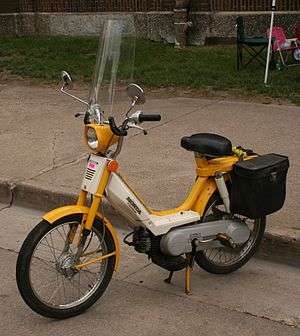
A moped (/ˈmoʊpɛd/ MOH-ped) is a small motorcycle, generally having a less stringent licensing requirement than motorcycles or automobiles because mopeds typically travel about the same speed as bicycles on public roadways. Strictly speaking, mopeds are driven by both an engine and by bicycle pedals, but in common usage and in many jurisdictions the term moped is used for similar vehicles including a scooter, though this is quite erroneous. Mopeds occasionally resemble powered bicycles, more commonly called a motorized bicycle, though since ca. 2006 there has been a glut of engine kits shipped from China (although Tanaka had offered drive kits since the 1960s) designed in theory to transform a standard bicycle into a motor vehicle but lacking the benefit of proper brakes and lighting. In addition, the added stresses can cause the rear rim to warp, and the spokes to break, and if the engine is the least bit out of alignment the drive chain will come off the drive sprocket, causing the rim to warp and the spokes to break, as well as lodging the chain in the chainstay and causing injury to the operator. Some mopeds are of a step-through type design, while others are step-over, or top tank, designs, having a motorcycle-like frame, including a "backbone" and a raised fuel tank (known as a top tank among moped enthusiasts), mounted directly between the saddle and the head tube. Most are similar to a regular motorcycle, only having the addition of pedals, in which the rider can both manually power the vehicle through a bicycle-like crankset in addition to a small displacement engine. Although mopeds usually have two wheels, some regions classify low-powered three- or (rarely) four-wheeled vehicles as a moped. Many states have laws on the books that anyone convicted of a DUI cannot legally operate any motor vehicle powered by gasoline for the entire length of their sentence.
Word origin
The word moped is a portmanteau of "motor" and "pedal", originally coined in Sweden. Like some of the earliest two wheeled motorcycles, all mopeds were once equipped with bicycle pedals. The name "moped" has now been applied by some regional governments to vehicles without pedals, based on criteria of restricted engine displacement, speed, and/or power output. This is a misnomer, as they are no longer "mopeds" at all, and might instead be called a "noped" if they appear to look exactly like a typical moped, but no longer include pedals.
History
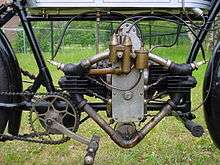
The term "moped" now only applies to low-power (often super-economy) vehicles, but pedals were fitted to some early motorcycles, such as the pictured 1912 Douglas. Pedalling away from stationary was a great improvement over "run and jump" and light pedal assistance (LPA) was valuable for climbing hills. Better transmissions with wider ranges, better clutches and much better engine performance made pedals obsolete on most motorcycles by 1918 but the pedals on mopeds remained valuable for their original purposes as late as the 1990s.
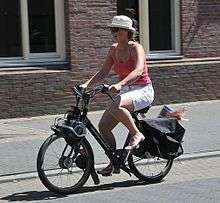
The earliest mopeds were bicycles with a helper motor in various locations, for example on top of the front wheel; they were also called cyclemotors. An example of that type is the VéloSoleX brand, which simply has a roller driving the front tire.
A more innovative design was known in the UK as the Cyclemaster. This had a complete powered rear wheel which was simply substituted for the bicycle rear wheel, which originated from a design by two DKW engineers in Germany. Slightly larger machines, commonly with a 98 cc (6.0 cu in) engine were known as autocycles. On the other hand, some mopeds, such as the Czech-made Jawa, were derived from motorcycles.
A further category of low-powered two-wheelers exists today in some jurisdictions for bicycles with helper motors – these are often defined as power-assisted bicycles or motorized bicycles. Other jurisdictions may categorize the same machines as mopeds, creating a certain amount of confusion. In many countries three-wheelers and microcars are classified as mopeds or variations thereof. This practice is not restricted to the third world; France and Belgium classify microcars such as the Aixam similarly or as "light quadricycles".[1] The Ariel 3, a motorised three-wheeler is classed as a moped.
Etymology
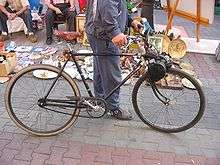
The word moped was coined by Swedish journalist Harald Nielsen in 1952, as a portmanteau of motor and pedal. It is however often claimed to be derived from "motor-velocipede.[2] According to Douglas Harper, the Swedish terms originated from "(trampcykel med) mo(tor och) ped(aler)", which means "pedal cycle with engine and pedals" (the earliest versions had auxiliary pedals).[3]
Other terms used for low-powered cycles include motorbicycle, motorized bicycle, motor-driven cycle, and goped (motorized inline skateboard with T-bar). The term noped is sometimes used for mopeds that do not have pedals. Motor scooters are sometimes referred to as mopeds.
Emissions
Mopeds can achieve fuel economy of over 100 mpg-US (2.4 L/100 km; 120 mpg-imp). The emissions of mopeds have been the subject of multiple studies. Studies have found that two-stroke 50 cc mopeds, with and without catalytic converters, emit ten to thirty times the hydrocarbons and particulate emissions of the outdated Euro 3 automobile standards.[4][5] In the same study, four-stroke mopeds, with and without catalytic converters, emitted three to eight times the hydrocarbons and particulate emissions of the Euro 3 automobile standards.[4] Approximate parity with automobiles was achieved with NOx emissions in these studies. Emissions performance was tested on a g/km basis and was unaffected by fuel economy. Currently in the United States, the EPA allows motorcycles, scooters, and mopeds with engine displacements less than 280cc to emit ten times the NOx and six times the CO as the median Tier II bin 5 automobile regulations.[6][7] An additional air quality challenge can also arise from the use of moped and scooter transportation over automobiles, as a higher density of motorized vehicles can be supported by existing transportation infrastructure.[8]
Racing
The wide availability of previously-used but still functional small motorcycles in western societies enables and encourages cheap forms of racing. Dirt-racing forms of this sport are sometimes staged in the stadiums of agricultural shows, where, unlike football and athletic grounds, the surface is not too important. One popular series uses chicanes consisting of stacked large-diameter tractor tyres and requires a team of riders, each doing ten laps and then pulling into the middle of the ring for change-over. Two heats and a final, each lasting 25 minutes, can be held in one day interspersed with speedway racing and other displays. Another series once held on full-size race-tracks, including Le Mans, ran for 25 hours (typically 3.00pm one day until 4.00pm the next) and was billed as "the longest race in the world".
Safety
Safely riding a moped mostly requires the same considerations as safely riding a motorcycle but the lower speeds, while reducing some dangers, increases others. The biggest danger is that other traffic may not notice the presence of a moped - bright clothes and reflective fittings help.[9] Drivers may even see the moped, recognize it as harmless to them and simply forget it's there, pulling out of side-turnings into its path. Similarly, a car approaching a moped from behind will approach it more quickly than the driver expects, and the driver's attention may be more attuned to other automobile traffic rather than the moped, increasing the likelihood of an accident. This is a particular problem for mopeds used on high-speed roads where they may not be intended to travel.
Mopeds are often illegally tuned for higher speeds, powers or engine displacements than allowed. For this to be legal, such vehicles should be re-registered as motorcycles, and their driver's license requirements, taxes, insurance costs and minimum driver age would be higher. A tuned vehicle, not designed for higher speeds, is not as safe as a purpose-designed motorcycle. A survey of Finnish high school students found that 80% and 70% of their mopeds were tuned, for vocational and gymnasium students, respectively. Only 10% of trade school students had a moped that conformed to legislation. The average maximum speed was 72 km/h, far higher than the legally allowable 45 km/h.[10] Another study reported that of school-age moped owners, 50% of boys and 15% of girls have an illegally tuned moped.[11]
Individual countries/regions
| Country / Region |
Regulations and variations, overlap with other powered two-wheelers |
|---|---|
| Australia | In the state of Queensland, small scooters of less than 50 cc (3.1 cu in) are able to be ridden with a car licence, and are restricted to 50 km/h (31 mph). Mopeds that do not meet Australian design specifications are not allowed on public roads, with the exception of electric bicycles equipped with a meagre electrical power-source (combustion engines cannot be used) of just 200 W (0.27 PS; 0.27 bhp). So called "monkey-bikes" were quickly made illegal as they gained huge popularity. Anything resembling an EU moped will need registration and an adult driver with a motorcycle licence.
Mopeds in Australia have to be ADR approved in order to be ridden on Australian roads. All requirements are listed in the consumer affairs website. Helmets are mandatory. |
| Austria | In Austria, a moped is defined as a motorized bicycle with at most 50 cc (3.1 cu in) and a maximum speed of 45 km/h (28 mph), which is close to the speed limit within towns (50 km/h (31 mph)). Since September 2009, drivers of mopeds have to be at least 15 years of age and in possession of a moped pass or a regular driver's license.[12] |
| Brazil | In Brazil, the definition of moped and the regulations regarding its use has been varying throughout the years. From 1985 to 1997, a moped was defined as human propulsion vehicle aided by an engine displacing less than 50 cc (3.1 cu in), no more than 3.0 hp (2.2 kW; 3.0 PS), having a maximum speed of no more than 50 km/h (31 mph) and having pedals similar to those found in a bicycle. No license was required.
From 1997 onwards, the legal definition of moped changed to "a two- or three-wheeled vehicle having an internal combustion engine with displacement inferior to 50 cc (3.1 cu in) and maximum factory speed of less than 50 km/h (31 mph)". The 1997 New Code of Transit also stated that any person aged 14 or older could ride a moped provided that person could read and be physically able. However, in 1998 the minimum age limit was changed to 18 years, since Brazilian Law does not allow minors to be criminally responsible, which contradicts the 1997 New Code of Transit, that states that being a criminally responsible is a requirement to be able to get a license. |
| Canada | In Canada the moped has been repealed from the Motor Vehicle Safety Regulations.[13] Nevertheless, the vehicle itself is still legislated within various provinces.
In Alberta, mopeds up to 49 cc (3.0 cu in) and over 55 kg (121 lb) used to require a class 6 motorcycle license. In 2009, weight restrictions were removed, and the speed limit increased from 50 km/h to 70 km/h. A Class 7 license is the minimum requirement to operate a Moped. They are allowed to carry more than one person provided the user is over 18 years of age. Mopeds are subject to all of the same traffic laws as other vehicles, and all riders must wear a helmet, while ensuring their moped is insured and registered.[14] Regulations have changed as of July 1, 2009, no longer a weight restriction and speed has increased to 70 km/h.[15] In British Columbia, mopeds (limited-speed motorcycles) and motor assisted cycles (MAC) have separate and distinct classifications and requirements. The following criteria apply to a moped (limited speed motorcycle):[16] Definition of a limited-speed motorcycle:
Requirements for operation of a moped (limited speed motorcycle):
In Ontario, "a moped is a motor-assisted bicycle fitted with pedals that can be operated at all times and has a maximum speed of 50 km/h (31 mph)".[17] A motor assisted bicycle is a bicycle:
Since 28 November 2005, moped drivers are required to have either a full M license or a restricted class M license to legally ride on roads in Ontario.[19] Prior to that date riders only required a G license. The G license is a "general" license for automobile drivers such as cars, small vans and trucks. |
| Denmark | Mopeds in Denmark are divided into "small mopeds" and "big mopeds", 'small' mopeds have a speed limit of 30 km/h (19 mph), and 'big' mopeds have one on 45 km/h (28 mph). Between 16 and 18 years of age, a moped driving license is required to drive the small moped. A car driver's or motorcycle license is needed and the driver must be at least 18 years old to drive a big one. All new mopeds (both types) bought after 1 June 2006 must be registered with a license plate, and have insurance. The older models are not required to have a license plate. All mopeds must now have insurance in Denmark. |
| European Union | The drivers license category for mopeds across the E.U. now is the AM driver's license. This license is for scooters and mopeds with no more than 50 cc (3.1 cu in), and a maximum speed of 45 km/h (28 mph). E.U. member countries that had not fully implemented the E.U. directive that refers to the moped and other drivers license categories had to do so by 2013 at the latest.
The "E.U. moped" is a scooter, moped (or similar) with two, three or four wheels, a maximum speed of 45 km/h (28 mph) and an obligatory license plate as proof of insurance. Many E.U. countries only require special insurer issued plates, not state issued plates. |
| Finland | Mopeds can be driven with an AM-class driving license, which can be obtained at the age of 15. People born before 1985 can drive a moped without a license. The power of an internal combustion engine moped is not limited, but the speed limit is 45 km/h (28 mph), and engine capacity can be a maximum of 50 cc (3.1 cu in) (with electric motor, maximum power is restricted to 4.0 kilowatts (5.4 PS; 5.4 bhp)). Mopeds are allowed to carry one passenger with the driver if the moped is registered as having two seats. Both driver and passenger are required to wear helmets. After Finland joined the European Union, EU regulations increased the maximum weight of moped and speed limit was increased from 40 to 45 km/h (25 to 28 mph). In Finland, like in all EU countries, it is illegal to drive a moped without a homologated safety helmet. |
| Germany | German law has two categories for mopeds. The first and slower category is the so-called Mofa, with a maximum design speed of no more than 25 km/h (16 mph) and only the driver is allowed on the bike, no passenger. Minimum age is 15 and no license is required, but a written test has to be completed.
The second category is the Moped, with a maximum design speed of 45 km/h (28 mph), minimum age is 16, a drivers license is required, one passenger is allowed if the moped or scooter is certified for a passenger. Both types need an insurer issued license plate, which is much smaller than regular state issued plates, which have to be renewed every 12 months, changing the color of the plates every year. Since a 16-year-old can now drive a 125 cc (7.6 cu in) bike, and scooters in the "moped" category allow for transporting a passenger comfortably, mopeds, even though they have less power, more appeal, and space, have almost disappeared as a result of the new E.U. laws. Most teens that don't have the money for the costly A1 driver's license (1st step towards the full motorcycle license), which allows them to drive a 125 cc (7.6 cu in) scooter or motorcycle, go for the less expensive AM driver's license, which allows them to drive a moped or scooter with a maximum speed of 45 km/h (28 mph), but less than 1% chose a moped over a scooter based bike. Modern scooter design and amenities have effectively changed how teens chose their first set of wheels in Germany. |
| Greece | Papi (usually 125cc) or papaki (usually 50cc) is the common local name for mopeds in Greece. Mopeds are usually powered by small two- or four-stroke engines, ranging from 50 to 125 cc (3.1 to 7.6 cu in). They are very popular among young people due to their low price, the low maintenance cost, and the vast stock of parts (original or tuning). Are widely used by all age groups, usually 13 and up. The most known "duckling" was the 1980s Honda 50 cc moped, which is still in use today. (Use of these mopeds requires a license [A1 category] and exams passed before attaining the license.) |
| Hungary | For a vehicle to fit within this category it has to be powered with a 50 cc (3.1 cu in) motor, and can only have a maximum designed speed of 45 km/h (28 mph). It can have 2, 3 or 4 wheels, if the vehicle has a covered passenger area such as a moped car, e.g.: (The Aixam micro car) wearing a motorcycle helmet is optional, otherwise it is mandatory, and the failure to wear one can be fined by the police. To drive a moped one needs to obtain a M ("moped") type European license, which one can get over the age of 14. Because mopeds are inexpensive compared to other forms of motorized transport, and the running expenses are low (the third-party insurance is only 2000 Ft-12 $- 8 €), and since they can be driven after obtaining inexpensive moped license, or "B" type car driver's licence, they have become quite popular in larger cities. Vehicles registered as mopeds cannot carry passengers (even if they have space for one) and they cannot use highways (however they can use bicycle roads at a limited speed of 20 km/h (12 mph)). Their maximum allowed speed on any road is 40 km/h (25 mph). You do not need to have a licence plate, but it is mandatory to have insurance paid (and proven by a yearly sticker plus the insurance papers must be carried along) to go on common roads. |
| Indonesia | Mopeds aren't allowed on Indonesian tollways. The drivers must be older than 17, get the driving license, register the vehicles and wear helmets. Motorcycle driving license holders also can drive them. The legally maximum speed is 100 km/h (62 mph)). |
| Ireland | A moped is defined as being mechanically propelled "bicycle" fitted with an engine having a capacity less 50 cc and a maximum design speed no more than 45 km/h.[20] By contrast, a motorcycle is defined in the same way, except that it has an engine larger than 50 cc or a top speed in excess of 45 km/h. The license category for a moped is "M". The minimum age to obtain a provisional (learner) or full license is 16, the same as for a class A1 (125 cc/11 kW) motorcycle. Holders of car, truck or bus licenses granted before 21 October 2006 have an automatic entitlement to a full moped license without taking a test. As with category A (unrestricted) and A1 motorcycles, a provisional license holder may not carry a passenger. |
| Italy | Mopeds aren't allowed on highways. Required age is 14, but a specific license ("patentino") is required. Owners of car or bike licenses may drive them freely. Registration (with plate) and insurance are mandatory. The law dictates all mopeds be restricted to 45 km/h (28 mph), but this is largely ignored and it's common for dealerships to sell them unrestricted if asked beforehand;[21] this is not tolerated by the authorities. The new law increases penalties up to €1338,59. Helmets are mandatory. Since 2006, a passenger may be carried on suitably built (dual seat) and registered mopeds. The driver must be over 18 years. Mopeds registered before this date that satisfy the technical and legal requirements may be re-registered (a new plate is issued) and used to carry a passenger. |
| Japan | Motorcycles with up to 50 cc (3.1 cu in) petrol engines or 0.6 kW (0.82 PS; 0.80 bhp) rated power generators are classified Motorized bicycle (原動機付自転車 gendoukitsuki-jitensha). The drivers must be older than 16, get the driving license, register the vehicles and wear helmets. Car driving license holders also can drive them. The legally maximum speed is 30 km/h (19 mph). |
| Malaysia | In Malaysia and some other Southeast Asian countries, small motorcycles are classified differently, most of the machines known as mopeds in the West (e.g. Honda Super Cub) are known as underbones (kapchai in Malaysia). These are the machines elsewhere known as scooters or sometimes "step-throughs". Kapchais have engines up to 150 cc (9.2 cu in), can reach speeds of 120–130 km/h (75–81 mph), and are used on public roads and expressways. Some people tuned up their mopeds for illegal racing on the highway, increasing the top speed of certain moped to be more than 200 km/h. |
| New Zealand | New Zealand - Mopeds can be driven with any class of driver license. Mopeds are classified as having an engine capacity not exceeding 50 cc (3.1 cu in) and a maximum speed not exceeding 50 km/h (31 mph). Electric mopeds must have a motor between 0.6 to 2 kilowatts (0.82 to 2.72 PS; 0.80 to 2.68 bhp). Mopeds do not require safety testing (known as a Warrant of Fitness in NZ) and are subject to lower licensing costs than motorcycles, though one still needs the right equipment (Helmet etc.). But the rider must license the moped (get plates etc.).[22] |
| Norway | All motorcycles having less than 50 cc (3.1 cu in) (and some "Mopedcars") are limited to 45 km/h (28 mph) in Norway. All two-wheeled vehicles with more than 50 cc are considered motorcycles. You need to be 16 years old and have a license (expensive) to drive one. Mopeds have only a 25% VAT and are therefore fairly cheap. Sixteen-year-olds can also drive 125cc bikes, and the license is only slightly more expensive than a moped license. But the 125cc bikes/scooters get a tax of about 1000-1200 Euros AND 25% VAT on top of that. Hence they cost 2-3 times as much as a moped.
Mopeds in Norway used to go at least 50 km/h (usually 55–65 km/h) before adaptation of EU regulations. With the 45 km/h speed limit tuning the engines are common. Until August 1, 2013 you could have a passenger on if they were under 10 years old, but from this date a passenger is no longer allowed. |
| Philippines | Many underbones, especially the Honda XRM and Honda Bravo, are modified, some are "pimped out" with stereo systems and neon lights, while others are tuned, even stripped to their frames, for illegal street racing. Others, however, are modified for aesthetics (ranging from only the bodywork to extensive modification, often to resemble a full superbike), or sometimes for usage as a transport capable vehicle (usually by the addition of a custom made side wagon). A moped (as any light motorcycle) is free to use but still requires a drivers license. However, mopeds and light motorcycles are not allowed to be used on the Manila highway or skyway system. |
| Poland | In Poland, a moped (called "motorower", from "motor bicycle"; this name also applies to scooters etc.) is a two- or three-wheeled motor vehicle that doesn't require the use pedals, equipped with an engine of 50 cc (3.1 cu in) or less, with a maximum speed of no more than 45 km/h (28 mph) (artificially limited in some models). Up to 19 January 2013 every person aged 18 or more was allowed to drive a moped without a license, only with an ID card. As of 2013, every person who became of age before 19 February 2013 is allowed to drive a moped, but younger people must obtain an appropriate license (categories AM, A or B). This law resulted in dramatically lowered sales of mopeds and job offers (such as pizza delivery) for younger people lacking job experience or money for driving license.[23][24] |
| Portugal | In Portugal, a moped is a two- or three-wheel motor vehicle with an engine of 50 cc (3.1 cu in) or less, or having an engine with more than 50 cc but with a maximum speed of no more than 45 km/h (28 mph). Class M (moped) license is required to drive such vehicles. This license can be obtained with a minimum age of 14. |
| Russia | The moped is legally defined as a two- or three-wheeled vehicle with engine displacement of no more than 50 cc (3.1 cu in) and maximum speed of no more than 50 km/h (31 mph). Such vehicles now require licensing, at least type M. Pillion passengers are not allowed. |
| Slovenia | Mopeds aren't allowed on highways. Required age is 14, but a specific license ("vozniško") is required. Owners of car or bike licenses may drive them freely. Registration (with plate) and insurance are mandatory. The law dictates all mopeds be restricted to 45 km/h (28 mph), but this is largely ignored and it's common for dealerships to sell them unrestricted if asked beforehand. Main manufacturer in Slovenia is Tomos |
| Spain | Mopeds are not allowed on highways. Helmets are mandatory. In Spain a moped is defined as a two- or three-wheeled motor vehicle with an engine of 50 cc (3.1 cu in) or less with a maximum speed of no more than 45 km/h (28 mph). The license needed for driving a moped is the 'AM' or Permiso de Conducir AM, which can be obtained at the age of 15 years. The driver is not allowed to transport passengers on the rear seat until 18 years of age. |
| South Africa | In South Africa a moped is defined as a scooter with a 50 cc (3.1 cu in) engine with a maximum speed of no more than 45 km/h (28 mph). There is no license needed for driving a moped and you can ride from the age of 16 years. The driver is not allowed to transport passengers on the rear seat until 18 years of age. |
| Sweden | Mopeds are available in two classes. Class 1 mopeds - also known as EU mopeds, as they were introduced to comply with European Union rules - are designed for a maximum speed of 45 km/h (28 mph) powered by an engine of 50 cc (3.1 cu in) or, if it has an electric motor, has a maximum power of 4.0 kW (5.44 PS; 5.36 bhp). A driver's license type A (motorcycle) or B (car), a driving license for tractor or a class 1 moped license (type AM, minimum age 15) is required to ride a class 1 moped. In traffic class 1 mopeds are regarded as motorcycles - but may not be driven on motorways or expressways - and has to be registered and have a license plate. They are however tax free. Class 2 mopeds are designed for a top speed of 25 km/h (16 mph) and has an engine with maximum 1.0 kW (1.36 PS; 1.34 bhp). No license is required, but the driver has to be at least 15 years old, have passed a theory test and wear a helmet. In traffic they are regarded as bicycles, and are allowed in the same places, unless signs explicitly forbid them. Mopeds registered before 17 June 2003, are called legacy mopeds, and are subject to the same rules as class 2 mopeds, but may have a top speed of 30 km/h (19 mph). |
| Switzerland | A moped is considered to be a two-wheeled vehicle that has pedals, a motor which is less than 50 cc (3.1 cu in) and a top speed of 30 km/h (19 mph). The moped must be registered, and must have a number plate with a sticker for that year indicating that the vehicle is road taxed and insured. Insurance is handled by the government. These vehicle are regarded bicycles in traffic and are therefore not allowed on motorways. To drive this vehicle, one must have a Category M license (which comes with every car and motorbike license) as well as a motorcycle helmet. A Category M license is obtainable at the age of 14. At the age of 16, one can obtain an A1 license to drive a 50 cc motorcycle which does not conform to the 30 km/h (19 mph) limit and therefore is not regarded as a bicycle anymore. |
| Thailand | The regulation of motorcycles in the city is different from the regulation for home use. Motorcycles in the city require payment of road tax and must have a valid license plate number. However, for home use, a motorcycle might not need to register and the motorcycle will only be able to be used in farms or a small town. Wearing a helmet is a must when riding on a major road and in the city. There is a maximum limit of one pillion riders on the bikes. |
| United Kingdom | 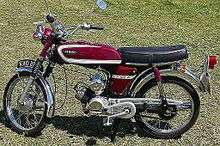 1970s Yamaha FS1E with functional emergency pedals Before 19 January 2013, the speed restriction was 50 kilometres per hour (31 mph),[26] and mopeds registered before 1 September 1977 were 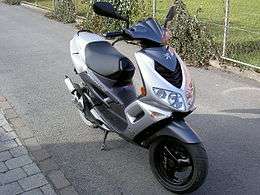 Peugeot Speedfight scooters are popular in the United Kingdom required to have pedal-assistance.[27] A provisional license, full motorcycle or car license is needed to operate a moped. An additional Compulsory Basic Training (CBT) certificate is also required to ride a moped on public roads, except for anyone who obtained their full car driving license before 1 February 2001 (though the UK Government recommends that all new riders take a CBT course). A provisional moped license may be obtained at the age of 16, whereas standard car and motorcycles licenses are only available at the age of 17. Provisional licenses require learner plates and expire after two years if the license holder has not passed a test, however it can be extended another two years by retaking the CBT. Mopeds are subject to all of the same traffic and vehicle regulation laws as other vehicles, including displaying a conforming rear registration plate. All motorised cycles, motorcycles and mopeds under 50 cc are prohibited from using UK motorways.[26][28] |
| United States | 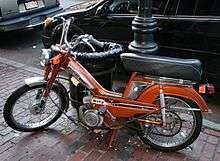 The French Motobécane "Moby" was a popular moped sold in the United States during the 1970s Prior to the 1970s, use of mopeds in the United States was relatively rare due to legal restrictions on the devices in many states. In 1972, Serge Seguin, after writing a masters thesis on the European moped, received two mopeds and a small amount of money from the French company Motobécane to promote the vehicle.[29] After lobbying Congress on its fuel efficiency benefits, Seguin was able to get more than 30 states to devise a specific vehicle classification for mopeds.[29] Produced by U.S. manufacturers such as American Machine and Foundry (AMF), mopeds had very small engines and often could not exceed 30 mph (48 km/h). What they could do, however, was run for up to 220 miles (350 km) on one tank of fuel. Because of the problems caused by the 1970s energy crisis, mopeds quickly became popular, with more than 250,000 people in the United States owning one in 1977. However, as gasoline prices eventually moved down, licensing laws took their toll, and automobile companies devised more efficient cars, the moped's popularity began to fade. Legal terms and definitions of low-powered cycles vary from state to state and may include "moped", "motorcycle", "motorized bicycle", "motorscooter", "scooter", "goped", "motor-driven cycle", and others. A moped's speed generally may not exceed 30 mph (48 km/h) on level ground, even if it is capable of going faster. In a few states this number is 20 or 25 mph (32 or 40 km/h), and in most states, the maximum engine capacity is 50 cc (3.1 cu in). However, Kansas ("Motorized Bicycle" K.S.A. 8-126, 8-1439a) allows up to 130 cc (7.9 cu in).[30] Some states (including California) require pedals, while others do not. |
| Vietnam | Parts of Vietnam (e.g. the major cities of Hanoi and Ho Chi Minh City) are amongst the last places in the world where two-wheeled personal transport is more important than four-wheeled transport. Mopeds, underbones/scooters and motorcycles are everywhere, partly due to the narrow nature of many of the sidestreets and alleys. |
Sports moped
In the United Kingdom during the 1970s, a high performance derivation of the moped concept were developed, aimed at 16-year-olds.[31] It was created in order to circumvent governmental legislation aimed at forcing young motorcycle riders off the road. These new laws, called the "Sixteener Law", were introduced by John Peyton, the then Conservative Party Minister for Transport in 1971. They forbid 16-year-olds from riding motorcycles of a 250 cc capacity as they had done before, and limited them to 50 cc machines until they were 17. The law provoked motorcycle manufacturers to develop new class of motorcycle which were then called "sports mopeds" or, colloquially, "sixteener specials" and was subject to much criticism.[32] The market for these was primarily young males.[33]
Sports mopeds were ostensibly 50 cc motorcycles, capable of doing more than 50 mph in some cases, with bicycle style pedals added to them as an after thought which the law required were capable of propelling the vehicle. Models were produced by Japanese manufacturers Honda, Yamaha and Suzuki, and European companies such as Puch, Fantic, Gilera, Gitane and Garelli from 1972 onwards, the most famous of which was the Yamaha FS1-E.[34] They included roadsters, enduro and motorcrossers, cafe racers and choppers or scooters,[35] and led to a boom interest in motorcycling similar to the early 1960 rocker period. The government responded again by bringing in even more restrictive legislation in 1977 which limited mopeds to a weight of 250 kg and a top speed to 30 mph. The move contributed to the demise of the UK motorcycle market.[36] In Continental Europe no such restrictions existed and such vehicles could be ridden by 14-year-olds.
A recent addition to the moped family is the Honda MSX-125 more commonly referred to as 'The Grom'. This particular vehicle is the choice of the modern day Mod movement and is more of a fashion statement than a practical vehicle.[36]
See also
- Daelim (Trac)
- Moped Army
- Angel/ Speedbird - closely related to Peugeot 102
- Batavus - HS-50 (top tank), Mondial ) powered by Peugeot 103) (Regency, Starflight, Laura M48 and M56 (Trac/ Daelim compatible engines)
- Honda, Indian, Jawa, Kreidler
- Minarelli (Beratta, Cimatti, Motron, Testi Cricket among others)
- Peugeot
- Puch
- Rabasa Cycles (Derbi)
- Sachs (Balboa, Eagle, G3 (top tank), Hercules, Prima, Optima, Suburban, Sundancer, Westlake) plus Her Chee Taiwan-origin frames such as AMS Sierra 50, , Flying Dutchman, General 5-star, Grycner Floozy, Kynast (Bully 4000 ans Flying Dutchman, also very rare 508= series (2-speed automatic centrifugal clutch), Jui Lin Honey 50, and Dutch-made Sparta Buddy/ Foxi - (504- 1A, 504 1/B, 504 1/C, 504 1/D, and 505- series (pedal shaft contained in engine case) 505/1 A thru D)
- Segway PT
- Tomos
- Vespa
References
- ↑ "Legislation". Aixam.com. Retrieved 2009-03-31. External link in
|work=(help) - ↑ "Moped - inget teleskopord". Dagens Nyheter (in Swedish). 2006-01-15. Archived from the original on 16 February 2006. Retrieved 2007-06-01.
- ↑ Harper, Douglas (November 2001). [etymonline.com "Moped"] Check
|url=value (help). Online Etymology Dictionary. Retrieved 2007-01-09. - 1 2 "Emissions from a Moped Fuelled by Gasoline/Ethanol Mixtures" (PDF). Schramm et al. Retrieved 2010-07-18.
- ↑ "Chemical characterization of emissions from modern two-stroke mopeds complying with legislative regulation in Europe (EURO-2)". Adams et al. Retrieved 2010-07-18.
- ↑ "Highway Motorcycles: EPA Regulations and Global Activity Update" (PDF). Retrieved 2011-06-10.
- ↑ "Untangling US Vehicle Emissions Regulations". Jason Kavanagh. Retrieved 2011-06-10.
- ↑ "2 Stroke Scooters International Projects Network" (PDF). IEA. Retrieved 2010-07-18.
- ↑ "Moped Survival Guide—Urban Two-Wheeled Warfare". Moped Army. Retrieved 2007-06-01.
- ↑ "Liikenneturva". Liikenneturva. Retrieved 13 October 2015.
- ↑ Keskisuomalainen. "Mopon virittäminen voi tulla kalliiksi". KSML.fi - Keskisuomalainen. Retrieved 13 October 2015.
- ↑ Republik Österreich. "HELP.gv.at: Erwerb der Klasse AM ("Mopedführerschein")". Retrieved 13 October 2015. horizontal tab character in
|title=at position 13 (help) - ↑ "Motor Vehicle Safety Regulations". Canadian Legal Information Institute. Retrieved 2007-06-01.
- ↑ "license Classes". Service Alberta. Archived from the original on 2007-05-04. Retrieved 2007-06-01.
- ↑ http://www.transportation.alberta.ca/Content/docType45/Production/MopedPowerBikes.pdf
- ↑ "ICBC - Register & License a Vehicle - "Mopeds" (limited-speed motorcycles)". ICBC. Retrieved 2008-06-26.
- ↑ "Has the definition of a moped changed?". Ontario Ministry of Transportation. Retrieved 2007-06-01.
- ↑ "Highway Traffic Act, R.S.O. 1990, c. H.8". Canadian Legal Information Institute. Retrieved 2007-06-01.
- ↑ "What does this new program mean for moped and LSM drivers?". Ontario Ministry of Transportation. Retrieved 2007-06-01.
- ↑ "S.I. No. 537/2006:Road Traffic (Licensing of Drivers) Regulations 2006". Irish Statute Book. Retrieved 2010-06-19.
- ↑ "Ciclomotori truccati, la Cassazione riporta l'ordine. La Suprema Corte annulla la sentenza di un GDP che aveva annullato la confisca disposta dopo un accertamento su un motorino elaborato". Associazione Sostenitori ed Amici della Polizia Stradale. Retrieved 22 May 2013.
- ↑ "Vehicle classes and the standards they must meet". Land Transport NZ. 2006-10-31. Retrieved 2007-06-01.
- ↑ Przemysław Borkowski. "Koniec karty motorowerowej: Teraz musisz zdawać Prawo jazdy AM". Retrieved 13 October 2015.
- ↑ Przemysław Borkowski. "Spada sprzedaż motorowerów w Polsce". Retrieved 13 October 2015.
- ↑ "Riding a motorbike, moped or motor tricycle - Part 3: Bike categories, ages and licence requirements". UK Government. Retrieved 3 April 2013.
- 1 2 "Information for moped riders". DirectGov. Retrieved 2007-06-01.
- ↑ "Information for moped riders". UK Government National Archives. Directgov. Retrieved 2 April 2013.
- ↑ "Road vehicles by type: 10.3". Department for Transport - TSGB Chapter 10: Notes and definitions. 2006-11-02. Retrieved 2007-06-01.
- 1 2 "Mopeds". Bad Fads Museum. Archived from the original on 17 February 2009. Retrieved 2009-03-30. External link in
|work=(help) - ↑ "Moped Laws by state". Retrieved 13 October 2015.
- ↑ How to Restore Yamaha FS1-E. John Watts. Veloce Publishing Ltd, 14 Jun 2006
- ↑ New Scientist, 4 Nov 1976. P.299
- ↑ Retail business, Issues 197-202. Economist Intelligence Unit (Great Britain). Economist Intelligence Unit Ltd., 1974
- ↑ James May's Magnificent Machines. James May, Phil Dolling. Hachette UK, 1 Mar 2012
- ↑ The Motorcycle Book. Alan Seeley. MotorBooks International, 2 May 2004
- 1 2 Funky Mopeds!: The 1970s Sports Moped Phenomenon. Richard Skelton. MBI Publishing Company, 1 May 2007
External links
| Wikimedia Commons has media related to Mopeds. |